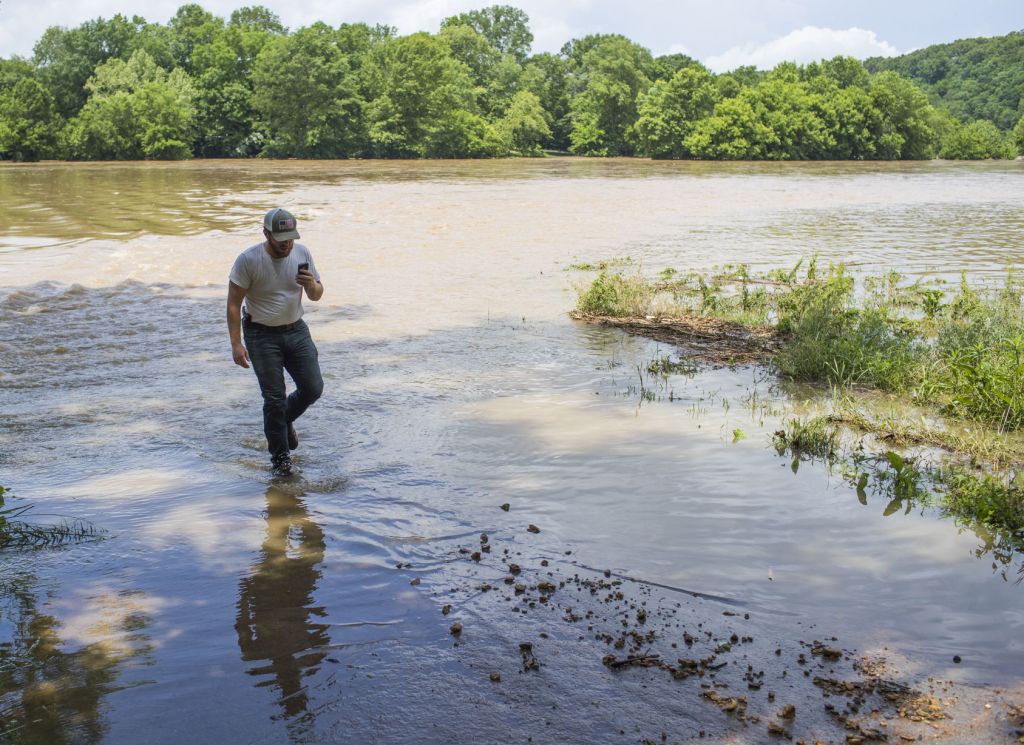Bowling Green in 2050: floods, droughts, warming
Published 6:00 pm Friday, March 8, 2019

- Tyler Lonas of the Scottsville-Allen County Rescue Squad wades through water where Lancaster Branch flooded over West Old State Road in Scottsville on May 19, 2017.
Imagine heat waves that prevent you from safely leaving your home for several days, flooding that damages dams and buildings and droughts that reduce the nutritional value of crops and lessen water quality.
This isn’t necessarily our future – but it could be.
Trending
In a scenario of unchecked greenhouse gas emissions, humanity could face a multitude of threats because of climate change, according to a paper published in Nature Climate Change.
Dr. Camilo Mora, professor at the University of Hawaii at Manoa and lead author of the paper, knitted data together on various climate change hazards to illuminate the bigger picture.
“By themselves, they are pretty bad. When you put them together, it’s a nightmare scenario,” Mora said.
Climate Central, a research and reporting organization of scientists and journalists, helped translate the implications of Mora’s paper for individual cities – as climate hazards vary by region.
Bowling Green’s top five threats are precipitation, drought, warming, water deficit and heat waves.
“Those are all consistent with our future predictions of climate,” said Stuart Foster, state climatologist for Kentucky and director of the Kentucky Climate Center. “It gives us more perspective in contemplating what a change in climate might mean for us.”
Trending
It starts with warming, which increases water evaporation, and warmer air can retain more moisture. On one hand, that can lead to drought and subsequent wildfires and heat waves. On the other hand, this can deliver heavier rainfall and subsequent soil saturation and flash flooding.
These swings, called “weather whiplash,” can stress dams, farms and people.
“We have to be prepared to deal with a wider range of extremes,” Foster said. “We have to build infrastructure that has a greater capacity to deal with those extremes,” and the fact that the population is growing compounds the challenge.
Directly, climate change can cause warming, heat waves, precipitation, drought, floods, fires, storms, sea-level rise and changes in natural land cover and ocean chemistry. Mora’s paper highlights how these hazards will affect people.
“Humanity depends on many things, and those things include health, food, water, infrastructure and security,” Mora said. “Those climate hazards independently influence all of these things.”
If Bowling Green experiences more heat waves, for example, then the demand for electricity will increase and subsequently stress both the grid and energy production – which will drive up customers’ utility bills. With extreme heat, more people might become heat exhausted, which will increase the need for more emergency response teams. If the heat waves stretch for multiple days in a row and don’t cool at night, then people might begin to feel trapped and agitated, and more likely to become involved in violent behavior, according to Foster.
“That has adverse effects on human health,” he said. “There are ways to mitigate flooding, but I don’t know how you mitigate (when), day after day, the temperature doesn’t get below 80 degrees.”
Predictions for climate hazards are nothing new. It’s fairly established climate science to say that the world will experience more intense climate hazards if the average temperatures continue to warm. That’s already happening.
The benefit of modeling different scenarios demonstrates what our future could look like if we do nothing, something or everything humanly possible to reduce carbon dioxide emissions and slow climate change.
“We use the best models that we have, so that we can understand better about what scenarios are possible and plausible,” Foster said.
Mora’s paper presents a scenario called representative concentration pathway, or RCP, 8.5. Under this scenario, the world continues to burn fossil fuels and conducts “business as usual.”
Since 2005, total global greenhouse-gas emissions have been mostly following the RCP 8.5 scenario, which is generally considered “the worst-case scenario.” (In 2018, U.S. carbon dioxide emissions increased by 3.4 percent after three years of declining emissions – and represented the second largest annual gain in emission in more than two decades, according to energy research firm Rhodium Group.)
Recently, researchers from Vox, NASA’s Jet Propulsion Laboratory and the Scripps Institution of Oceanography utilized this same scenario to produce estimates for various U.S. cities’ future summers and winters. In Bowling Green, both the average summer high temperature and also the average winter low temperature will increase by 5.2 degrees Fahrenheit by 2050.
When average temperatures increase even just a few degrees, the result can be more extreme weather events, such as heat waves and thunderstorms. The greater the shift in average, the greater the threat of severe weather.
But actually, the scenarios could be even worse due to climate “tipping points.” Picture this: stratocumulus clouds in the Earth’s atmosphere – which reflect sunlight and help cool the climate – disintegrate and increase the global mean surface warming by 8 degrees Celsius, as introduced in a paper published in Nature Geoscience last month. (The global Paris Agreement aims to limit the temperature increase to 1.5 degrees or below pre-industrial levels.)
In 2019, Australia faced its hottest recorded January followed by flooding. Cities across Europe endured daily heat records and hundreds of wildfires. Bowling Green had the second wettest February on record with 11.14 inches – and a daily rainfall record Feb. 6, according to the National Weather Service in Louisville.
It might seem like young generations won’t know anything but records due to warming averages.
Today’s youth “will experience things that their parents or grandparents never experienced, and in other cases they’ll never experience what their parents or grandparents experienced,” Foster said.
There is a faint – very faint – gray lining with this possible future, according to Foster.
As climate change affects other regions across the U.S. – potentially more severely – Kentucky will have an abundance of precipitation accompanying its numerous streams, rivers and reservoirs network.
“As water becomes a more and more valuable resource, Kentucky has the potential to fare perhaps better than other states and other parts of the country,” Foster said. “Even though our conditions will become harsher, we may look better than some other areas.”






